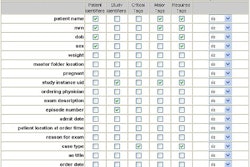It's not well known, but most institutions choose their PACS vendor well in advance of the purchasing process. Facilities usually know which vendor they would prefer to use for PACS, and employ a variety of tactics to ensure that the vendor of choice gets the deal, or is at least one of the final two considered. And why is this done? Politics.
If the decision is already made, why then do hospitals use tools like requests for proposals (RFP), go on site visits, and spend months looking at technology from other vendors? The answer is easy. Hospitals need to get multiple bids from different vendors to cover themselves politically. Before committing millions for a PACS network, almost every board of directors will undoubtedly ask if competitive bids were requested, and where the selected vendor fell in the rankings.
Hospitals need to prove they have done their due diligence, and as such can show various bids, even if none of the competitive bids were looked at closely. It’s part of the game being played. Vendors play the game as well, responding to RFPs when they know that chances are they won't even get in the game.
PACS is impacted by politics much more than other purchases are because the choice of vendor affects so many different entities within the facility. Unlike a modality purchase, where ostensibly the vendor selection is made jointly by the administrative director of radiology, radiologists, and sometimes technologists, PACS also involves individuals from the hospital’s information technology (IT) department, hospital administration, and others, each lobbying for their personal favorites.
IT may have established a hospital-wide strategic focus of using a single-vendor solution for all clinical systems. As such, IT may lobby to select the PACS solution from the company providing the foundation of the clinical patient record (CPR). Unfortunately, this choice might not be the best to meet the radiology department's needs.
The thought process that "integrated is better than interfaced" has caused many hospitals to make decisions that were not in the best short- or long-term interest of their facility, even if it seemed like a logical argument at the time. This mode of thinking has also driven virtually all of the major PACS vendors and many of the independents to embrace integrated PACS/RIS solutions in the past few years, offering these as a competitive solution to "stand-alone" PACS.
In several instances it has actually cost the hospital more money to implement an integrated solution, owing to required upgrades to existing applications software and hardware infrastructure. Radiologist and technologist productivity gains may also not be achieved in the time frames projected due to the limited functionality of the PACS network, even if there were some slight advantages to upgraded functionality of the integrated RIS.
Dealing with politics is not easy, but can be handled in a way that leaves everyone with a modicum of satisfaction. First, expectations for all parties need to be managed. The vendor that you preferred may not be selected for a variety of reasons, including political ones, but as long as the PACS performs well and meets the overall expectations of a facility, the choice of the PACS vendor really should be moot.
Handling the team
Most facilities take a team approach to PACS, getting input from a variety of sources. At a minimum, the PACS evaluation team should consist of the administrative director of radiology, one or more representatives of the radiology group, hospital administration, one or more members from the information services (IS) department, and if/as applicable, any individuals who possess PACS or RIS responsibility in the hospital.
In theory, each individual has an equal vote. In reality, however, the one who pushes the hardest for his or her solution is usually the one who gets his or her choice of the PACS vendor.
The role that radiologists play in the PACS evaluation process should ideally be relegated to reviewing and commenting on the diagnostic workstation operation and functionality, and how it will impact their productivity. This information should be factored into the overall evaluation process, and should be weighted as no more than 20% of the total vote.
I’ve seen radiologist input on workstations drive the final decision on PACS way too many times, with the tail wagging the dog time and again. Don't let this happen.
It's critical, of course, for radiologists to feel comfortable with workstation operation. What many people fail to realize, however, is that the workstation is a small fraction of the total system. Time and time again we also see one or two radiologists with a level of technical expertise far superior to that of their counterparts, yet who just know enough to get themselves in trouble and not enough to get themselves out.
Allowing a single individual with limited technical knowledge to try and sway the balance of the team with their "full understanding" of a PACS vendor borders on the absurd. None of us is as smart as all of us; PACS should be a team decision.
Radiologists are not IT or network specialists, and really do not understand many of the technical subtleties and nuances that go into a PACS network. They should provide feedback on how this system will impact their ability to perform diagnostic interpretations.
The squeaky wheel
PACS should be a team purchase, with each player contributing to the decision in their area of expertise. More often than not, however, the loudest voice or squeakiest wheel drives the balance of the team’s decision.
I’ve been involved in engagements where one vendor appeared to be the clear-cut winner, yet lost out to another firm. In a nutshell, radiologist pressure impacted the team’s decision to purchase the vendor of their choosing, pretty much solely because they preferred that vendor. When the team wanted to go with the vendor that had the more suitable offering, the radiologists said they would boycott the hospital's decision and not use the system.
This left the hospital in a conundrum -- should they buy the system that is best for the facility but won’t be used by radiologists, or buy the system that the radiologists preferred but that wasn’t the best choice for the facility? In the end, both hospitals elected to cave in to the radiologists’ demands, justifying their actions as a refusal to "throw away money on a system that won't be used."
To avoid situations like this, query the PACS evaluation team before an RFP is released. Ask if there are any vendors whom the team members feel so strongly about that no others will be considered, or if there are any vendors whom they will not consider at all. This will save a lot of time and heartache early on if you know this information up-front.
Polling radiologists is especially critical, as I’ve never found an administrative director or other person who likes his or her job that's willing to take on the department chairman, if he or she has a personal agenda to implement a particular vendor's PACS network.
Relationships in PACS drive the vast majority of decisions. The sooner in the process this is discovered the better and often faster the decision-making process will go. Unfortunately, relationships can be extraordinarily complex and involve multiple players in a single facility.
Preexisting relationships with modality and film vendors are a given, but hospitals must also consider the established relationship with the radiology information system (RIS) vendor, especially if they offer a clinical patient record (CPR) solution, and any existing PACS subsystem vendors as well. This is especially critical if the radiology group has made financial investments in a teleradiology or other PACS subsystem, even if the return on investment (ROI) has long been achieved.
Nepotism and personal relationships aren’t seen very often, but need to be recognized as a possible potential conflict of interest and political nightmare as well. This usually happens when a spouse or other individual happens to either work for or somehow have a relationship to an individual within a company being considered.
These relationships are sometimes disclosed in advance but often aren't. In any event, the person on the team who is related to the company representative wants the vendor to at least be seriously considered. As a courtesy, the team should consider the vendor, providing it does not impact on other vendor opportunities as well. No decision should be made or impacted based on personal relationships.
Even rarer than nepotism, but still occurring, are situations wherein a hospital, radiology group, or individual(s) has some financial connection to the company and lobbies exceptionally hard to get the vendor considered. Financial links should always be disclosed, but this may not be as clear as imagined -- especially if the investments are in a private company that does not have to disclose its financial backers. Again, this is a situation where no decision should be made or impacted based on such relationships.
Politics always rears its ugly head in PACS decisions, but by managing the situation you can minimize the impact. Recognize that you can’t change reality, but you can manage politics if you ask the right questions ahead of time. This saves time, money, and, above all, aggravation in what can be one of the most important (and expensive) decisions a hospital will ever face.
AuntMinnie.com contributing writer
June 6, 2003
Michael Cannavo is president of Image Management Consultants, a PACS and healthcare information systems consulting firm based in Winter Springs, FL. He can be reached at
Related Reading
PACS brings benefits, with caveats, May 22, 2003
Web-based integration of PACS and RIS systems improves workflow, patient care, May 12, 2003
PACS archive techniques continue to evolve, March 18, 2003
Copyright © 2003 AuntMinnie.com



















